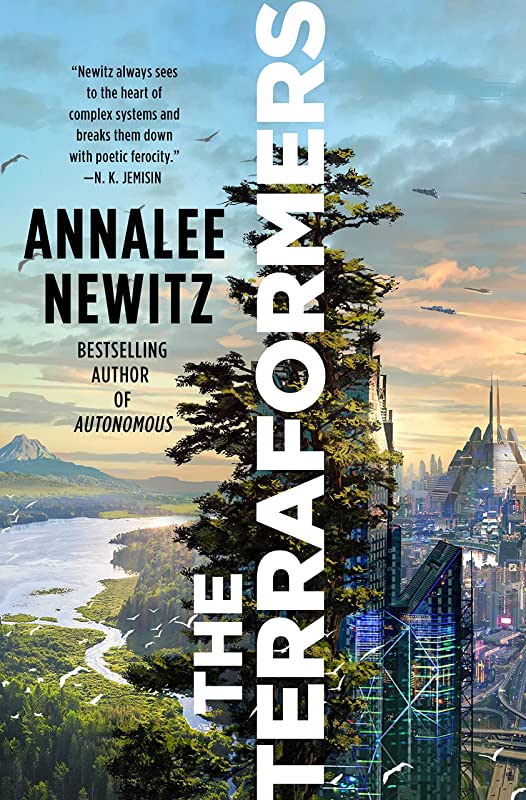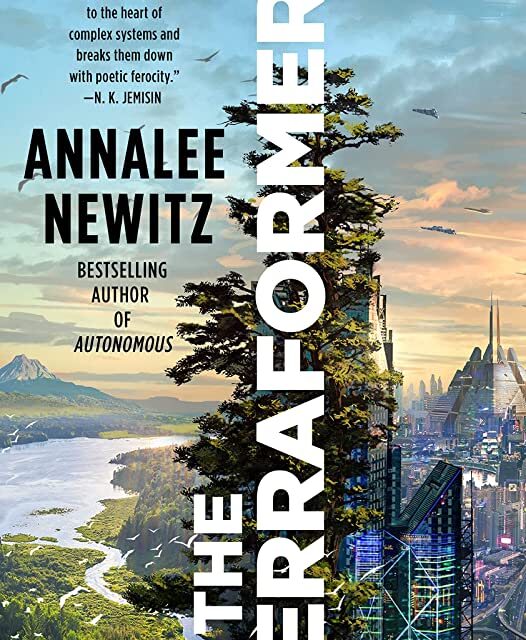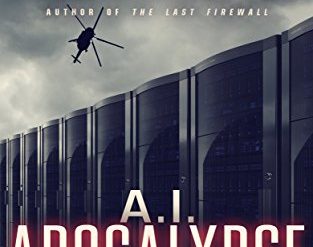
When Berkeley-based science fiction author Annalee Newitz set out to write a novel about a hopeful future, The Terraformers was the result. And I am here to report that they succeeded brilliantly. It’s set at a far-distant time when the human race has spread among thousands of worlds throughout the galaxy. The action spans 1,600 years, yet it all hangs together like a fine tapestry on the wall. The book is a tour de force of ingenuity. Almost every chapter offers up some marvelous figment of Newitz’s imagination. The novel oozes optimism, but it is no dreamy fantasy tale. War, revolution, greed, and aggression propel this story. If The Terraformers isn’t a contender for the Hugo, Nebula, Locus, and John W. Campbell awards, I’ll be surprised.
In the year 59,006
The first of the novel’s three parts opens in the year 59,006. For 10,000 years, the Verdance Corporation has been terraforming the planet SASK-E, known as Sasky. It’s thousands of light-years distant from Earth. An Environmental Rescue Team, or ERT, is engaged in ecosystem management, helping ensure that the planet will be ready for sale to settlers within just a few hundred years. Team leader Destry Thomas and her companions stumble across a thriving community called Spider City built illegally within a network of lava tubes under a volcano. And that discovery will lead them into open conflict with Verdance’s ruthless VP of special operations, Ronnie Drake. But Destry has gained a resourceful and clever ally from Spider City named Sulfur. Together, they are formidable. But Ronnie wields enormous power.
“Verdance had paid to build this planet, including its biological labor force. Everything here—other than rocks, water and the magnetic field—was part of Verdance’s proprietary ecosystem development kit. And that meant every life form was legally the company’s property, including Destry.” So even with Sulfur’s help, Destry will face great danger when she defies Ronnie. Spider City’s future hangs in the balance, too.
The Terraformers by Annalee Newitz (2023) 352 pages ★★★★★

A hopeful future beyond the bounds of our dreams
The life Destry Thomas experiences is unlike ours in fundamental ways, beginning at its inception. People are not born but decanted, having been designed by bioengineers. They enter life fully grown and endowed with the capacity to live for hundreds, even thousands of years. Equally important, sixty thousand years ago a series of events known as the Farms Revolutions led to the Great Bargain.
First, farm animals, and then many other species of animals and plants, gained sentience in the bargain. Robots and other machines did, too—and a great many achieved a level of intelligence that permits them to be called persons. Cows, moose, beavers, naked mole rats, owls, cats—they’re all people unless the engineers inhibit their cognitive abilities. Those whose brains have built-in limiters are merely Mounts or Blessed, with intelligence so severely constrained that they’re capable of doing and thinking only about a single task. They’re not people. They’re animals.
Meanwhile, the genus Homo has branched out. H. sapiens continues to dominate in many ways, but examples of H. diversus abound, “with every possible configuration of limbs, skull shapes, and skin textures.” Some are built to adjust to the harsh environment on newly terraformed planets. Others have extra limbs or sensory organs designed to assist them in specialized tasks such as surgery. Some are bionic, others entirely biological. Those with gravity mesh under their skin can fly.
And every person, of every species, has the ability to change to a new body at will. This becomes convenient when sex is involved. Otherwise, how could a naked mole rat or a doorway make love with a human being?
Corporate intrigue and revolution
The novel’s second part opens in 59,706. Now, Destry’s trainee, an H. sapiens named Misha, leads the Verdance ERT on a mission to survey the planet for intercity transit. In the seven hundred years that have elapsed, cities have sprouted on Sasky. One even has a population of one million. Ronnie’s orders to the team reflect her commitment to maximizing her company’s profit. Accordingly, she has instructed them to plan for railroad tracks to be laid from one city to another. Her intent is clear. A train system will prove too inflexible as the population increases and new cities are built. Residents will be forced to turn to private operators. Thus, within a century or two Verdance will be freed from the need to support the transit system.
Meanwhile, Cylindra, a former Verdance executive Ronnie had fired, is now a power on Sasky. The Emerald Corporation has hired her to manage their vast real estate holdings on the planet. Emerald Corporation is building (and owns) most of Sasky’s cities. Cylindra plans to reserve them for H. sapiens and convert the planet into a Pleistocene refuge. After all, Sasky is “ripening into one of the few known Earthlike worlds in the League—and that made it an enticing outlier among the thousands of habitable planets that speculators were terraforming at any given time.” And “out there, in the volume of galactic space claimed by the League, some people believed you weren’t really human unless you’d experienced a Pleistocene environment on an Earth-like world. Hence the lure of her planet, SASK-E.”
But Cylindra resists Ronnie’s plan to lay train tracks not because it will frustrate her own plans. There’s a deeper reason. Cylindra loathes Ronnie and is unwilling to go along with anything she has conceived. Their rivalry, and a festering conflict involving the people of Spider City and both of the ruthless and vindictive corporate executives, flares into the open. Misha and his colleagues in the ERT are caught in the middle. But their friends in Spider City save the day with an ingenious solution: sentient, flying trains.
Revolution comes to Sasky
It’s the year 60,610 as Part III opens. Scrubjay is one of the numerous flying trains that tie together Sasky’s cities. But all is not well there. Cylindra is driving out of the cities people who aren’t H. sapiens. The Emerald Corporation is marketing Sasky as a rare planet reserved for human beings inhabiting H. sapiens bodies the company decants from heirloom DNA. New arrivals must purchase them to live there. And Cylindra’s ambition goes much further than the limits of the Emerald cities. She is seeking to take over the whole planet—including Spider City, which is guaranteed its independence by treaty. Revolution breaks out—and the planet’s future is in doubt.
Thus, life on Sasky is never free from strife. Some of the worst aspects of human nature remain in force. Undeniably, though, this is a hopeful future. Despite occasional upheavals, at the end of the novel,”Everything is in balance,” to quote the time-honored greeting of the Environmental Rescue Teams. And what more could we hope for?
About the author

From the author’s website: “Annalee Newitz writes science fiction and nonfiction. They are the author of Four Lost Cities: A Secret History of the Urban Age and Scatter, Adapt and Remember: How Humans Will Survive a Mass Extinction, which was a finalist for the LA Times Book Prize in science. They’re also the author of the novels The Terraformers, The Future of Another Timeline, and Autonomous, which won the Lambda Literary Award. As a journalist, they are a writer for the New York Times and elsewhere, and have a monthly column in New Scientist. They have published in The Washington Post, Slate, Popular Science, Ars Technica, The New Yorker, and The Atlantic, among others. They are the co-host of the Hugo Award-winning podcast Our Opinions Are Correct. Previously, they were the founder of io9, and served as the editor-in-chief of Gizmodo.”
Long based in Berkeley, Newitz has been the partner of the award-winning fantasy author Charlie Jane Anders since 2001.
For related reading
This is one of The 21 best books of 2023.
I’ve read the author’s two previous novels and three of the six nonfiction books she’s written to date:
- Autonomous (In 2144, Arctic resorts, autonomous robots, and killer drugs)
- The Future of Another Timeline (Alternate feminist history by a gifted science fiction author)
- Scatter, Adapt, and Remember: How Humans Will Survive a Mass Extinction (Will the human race survive climate change and a mass extinction?)
- Four Lost Cities: A Secret History of the Urban Age (Join archaeologists at work around the world)
- Stories Are Weapons: Psychological Warfare and the American Mind (Propaganda, conspiracy theories, and psyops in American history)
You might also enjoy Good books by Berkeley authors.
For more good reading, check out:
- These novels won both Hugo and Nebula Awards
- The ultimate guide to the all-time best science fiction novels
- 10 top science fiction novels
- Good books about space travel
- The top 10 dystopian novels
- 10 new science fiction authors worth reading now
And you can always find my most popular reviews, and the most recent ones, on the Home Page.



























Sounds like a bunch of books here I’ll want to read. Thank you for this blog, Mal!